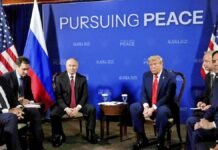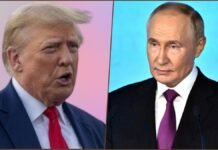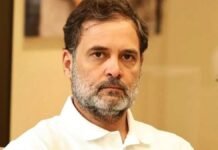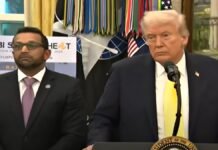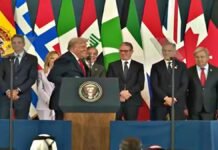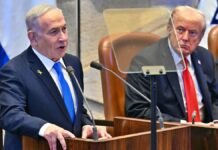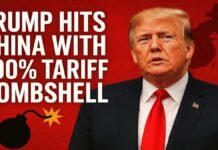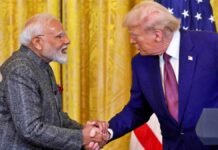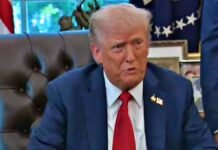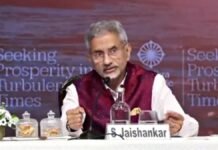
Key Highlights
- President Trump held a “very productive” 2+ hour phone call with Putin on October 16, 2025, marking their first dialogue since August
- Trump and Putin agreed to meet face-to-face in Budapest, Hungary, potentially within the next two weeks to discuss ending the Ukraine war
- High-level US-Russia diplomatic talks will commence next week, led by Secretary of State Marco Rubio and Russian Foreign Minister Sergey Lavrov
- Ukrainian President Zelensky meets Trump at the White House on October 18, 2025, requesting long-range Tomahawk missiles
- Russia warns that supplying Ukraine with Tomahawk missiles would escalate tensions and jeopardize peace negotiations
New Delhi: With the successful mediation of the Israel-Hamas ceasefire in Gaza, President Donald Trump has turned his diplomatic attention to ending the prolonged Russia-Ukraine conflict. The timing appears strategic, as Trump leverages his Middle East diplomatic victory to tackle what he calls the “inglorious” war between Russia and Ukraine.
Surprise Phone Call Breakthrough
On October 16, 2025, Trump and Putin engaged in their first conversation since their August summit in Alaska, which lasted over two hours. Trump described the discussion as “very productive,” announcing on Truth Social that “great progress was made” during their telephone exchange.
The Kremlin confirmed the conversation was “extremely frank and trustful,” with Putin’s aide Yuri Ushakov stating that preparations for the summit would begin “immediately”. Notably, the call was initiated by Russia, suggesting Moscow’s eagerness to engage in diplomatic dialogue.
Budapest Summit Details and Diplomatic Preparations
Trump announced that he and Putin will meet in Budapest, Hungary, although no specific date has been confirmed beyond “within the next two weeks.” The choice of Hungary as the venue is significant, given Hungarian Prime Minister Viktor Orban’s friendly relations with Russia and his consistent support for peace negotiations.
Orban expressed enthusiasm about the development, posting on X: “The anticipated meeting between the American and Russian presidents is excellent news for peace-loving individuals globally. We are prepared!”. He later confirmed having spoken with Trump about preparations for the USA-Russia peace summit.
High-Level Diplomatic Groundwork
Before the Trump-Putin summit, senior officials from both nations will convene next week to lay the groundwork. The American delegation will be led by Secretary of State Marco Rubio, while Russia will be represented by Foreign Minister Sergey Lavrov. The location for these preparatory talks remains undisclosed.
Zelensky’s White House Visit and Tomahawk Missile Request
The timing of Trump’s announcement comes strategically, just one day before Ukrainian President Volodymyr Zelensky’s scheduled White House meeting on October 18, 2025. Zelensky plans to advocate for increased military assistance, particularly requesting US-manufactured long-range Tomahawk missiles that could strike deep into Russian territory.
However, the Kremlin has issued stern warnings about such weapons transfers. Putin reportedly cautioned Trump that supplying Ukraine with Tomahawk missiles would represent a “new level of escalation” and jeopardize US-Russia relations and the peace process. Trump himself acknowledged this concern, telling reporters, “What do you expect him to say, ‘Please provide Tomahawks?’ No, he doesn’t want Tomahawks supplied to Ukraine,” referring to them as a “destructive weapon”.
Ukraine’s Response and Strategic Positioning
Zelensky, already in Washington for his White House visit, interpreted Putin’s eagerness for talks as a sign of weakness, stating: “We can already see that Moscow is eager to resume dialogue as soon as it hears about Tomahawks”. He emphasized leveraging the momentum from the Gaza ceasefire success, posting on X: “We hope that the defeat of terror and the success achieved in the Middle East will help to stop Russia’s war against Ukraine”.
Ongoing War Developments
The diplomatic breakthrough comes as the Russia-Ukraine conflict continues to escalate. On October 16, Russian forces launched dozens of drones overnight targeting critical Ukrainian infrastructure, particularly energy facilities. The war, which began in February 2022, has displaced millions and caused thousands of civilian casualties, with no signs of abating despite Western sanctions and military support [original article context].
Expert Analysis and Challenges Ahead
Despite the diplomatic momentum, experts remain cautious about the prospects for peace. The fundamental positions of both sides remain far apart – Russia demands Ukraine’s commitment not to join NATO and negotiations over eastern territories, while Ukraine insists on full restoration of its sovereignty and borders [original article context].
Trump’s confidence in his dealmaking abilities was evident when he told reporters at the White House: “I have spent my entire life making deals. I believe we can finalize this one, hopefully in the near future”. He also mentioned that both leaders “dedicated a considerable amount of time discussing trade relations between Russia and the United States once the war in Ukraine concludes”.
Global Implications
If successful, this diplomatic initiative could mark a major turning point in global politics and represent Trump’s second significant peace achievement following the Gaza ceasefire. The world watches closely to see whether Trump can deliver on his campaign promise to end the Ukraine war, or whether this proves to be another diplomatic overture without lasting results.
The Budapest summit represents the highest-level direct engagement between Washington and Moscow since the war began, potentially offering the first concrete pathway toward peace negotiations in nearly three years of conflict.


